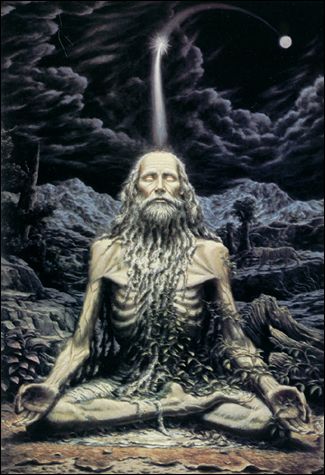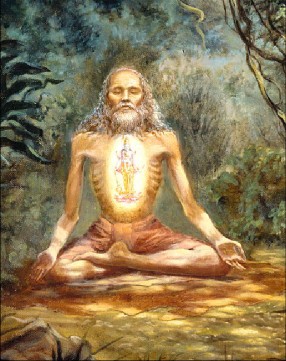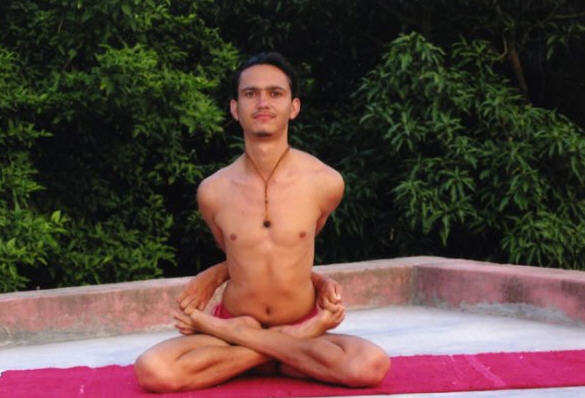There is more to yoga than just physical fitness and mystic powers.
The ultimate goal of yoga is to realize the presence of God within the heart.
The Eight Mystic Perfections
The mystic perfections achieved by actually successful yogis are eight in number. Anima-siddhi refers to the power by which one can become so small that he can enter into a stone. . . . Similarly, all of the yoga-siddhis, or perfections, are material arts. . . . In one yoga-siddhi there is development of the power to become so light that one can float in the air or on water. . . . A mystic yogi can enter into the sun planet simply by using the rays of the sunshine. This perfection is called laghima. Similarly, a yogi can touch the moon with his finger. . . . This siddhi is called prapti, or acquisition. With this prapti-siddhi, not only can the perfect mystic yogi touch the moon planet, but he can extend his hand anywhere and take whatever he likes. He may be sitting thousands of miles away from a certain place, and if he likes he can take fruit from a garden there. This is prapti-siddhi. . . . By the yoga-siddhi known as isita one can create and destroy an entire planet simply at will. Another perfection is called vasita, and by this perfection one can bring anyone under his control. . . . There is another mystic perfection, which is known as prakamya (magic). By this prakamya power one can achieve anything he likes. For example, one can make water enter into his eye and then again come out from within the eye. . . . The highest perfection of mystic power is called kamavasayita. This is also magic, but whereas the prakamya power acts to create wonderful effects within the scope of nature, kamavasayita permits one to contradict nature in other words, to do the impossible.
(Nectar of Devotion, Chapter 1)
What is Astanga-yoga?

When jnana-yoga increases in meditation on the Supersoul by different physical processes, and the mind is on Him, it is called ashtanga-yoga.
(Gita 6.47, purport)
Ashtanga-yoga is practice in concentrating the mind, releasing oneself from all engagements by the regulative processes of meditation, concentration, sitting postures, blocking the movements of the internal circulation of air, etc.
(Bhagavatam 2.5.16, purport)
The ashtanga-yoga system is a materialistic art of controlling air by transferring it from the stomach to the navel, from the navel to the heart, from the heart to the collarbone, from there to the eyeballs, from there to the cerebellum and from there to any desired planet.
(Caitanya-caritamrta, Adi 5.22)
Meant for Whom?
The process of restriction from sense enjoyment by rules and regulations is something like restricting a diseased person from certain types of eatables. The patient, however, neither likes such restrictions nor loses his taste for eatables. Similarly, sense restriction by some spiritual process like ashtanga-yoga, in the matter of yama, niyama, asana, pranayama, pratyahara, dharana, dhyana, etc., is recommended for less intelligent persons who have no better knowledge.
(Gita 2.59, purport)
There are still others who engage themselves in different kinds of mystic yogas like the Patanjali system (for merging into the existence of the Absolute), or hatha-yoga or ashtanga-yoga (for particular perfections). And some travel to all the sanctified places of pilgrimage. All these practices are called yoga-yajna, sacrifice for a certain type of perfection in the material world.
(Gita 4.28, purport)
After explaining the above principles of liberation in the Supreme, the Lord gives instruction to Arjuna as to how one can come to that position by the practice of the mysticism or yoga known as ashtanga-yoga . . . . In the Sixth Chapter the subject of yoga is explicitly detailed, and at the end of the Fifth it is only preliminarily explained. One has to drive out the sense objects such as sound, touch, form, taste and smell by the pratyahara process in yoga, and then keep the vision of the eyes between the two eyebrows and concentrate on the tip of the nose with half-closed lids. There is no benefit in closing the eyes altogether, because then there is every chance of falling asleep. Nor is there benefit in opening the eyes completely, because then there is the hazard of being attracted by sense objects. The breathing movement is restrained within the nostrils by neutralizing the up-moving and down-moving air within the body. By practice of such yoga one is able to gain control over the senses, refrain from outward sense objects, and thus prepare oneself for liberation in the Supreme. This yoga process helps one become free from all kinds of fear and anger and thus feel the presence of the Supersoul in the transcendental situation.
(Gita 5.27–28, purport)
It’s Purpose

The [ashtanga-] yoga system is a mechanical way to control the senses and the mind and divert them from matter to spirit. The preliminary processes are the sitting posture, meditation, spiritual thoughts, manipulation of air passing within the body, and gradual situation in trance, facing the Absolute Person, Paramatma. Such mechanical ways of rising to the spiritual platform prescribe some regulative principles of taking bath daily three times, fasting as far as possible, sitting and concentrating the mind on spiritual matters and thus gradually becoming free from visaya, or material objectives.
(Bhagavatam 1.13.53, purport)
According to Patanjali, when one is fixed in constant realization of the supreme form of the Lord, one has attained the perfectional stage, as attained by Kardama Muni. Unless one attains this stage of perfection beyond the perfection of the preliminaries of the yoga system there is no ultimate realization.
(Bhagavatam 3.21.12, purport)
Lord Kapila, the Personality of Godhead, who is the highest authority on yoga, here explains the yoga system known as ashtanga-yoga, which comprises eight different practices, namely yama, niyama, asana, pranayama, pratyahara, dharana, dhyana and samadhi. By all these stages of practice one must realize Lord Vishnu, who is the target of all yoga. There are so-called yoga practices in which one concentrates the mind on voidness or on the impersonal, but this is not approved by the authorized yoga system as explained by Kapiladeva. Even Patanjali explains that the target of all yoga is Vishnu. Ashtanga-yoga is therefore part of Vaisnava practice because its ultimate goal is realization of Vishnu. The achievement of success in yoga is not acquisition of mystic power, which is condemned in the previous chapter, but, rather, freedom from all material designations and situation in one’s constitutional position. That is the ultimate achievement in yoga practice.
(Bhagavatam 3.28.1, purport)
Features of Ashtanga-yoga
The yoga system as generally understood is ashtanga-yoga, or siddhi, eight-fold perfection in yoga. By dint of perfection in yoga one can become lighter than the lightest and heavier than the heaviest; one can go wherever he likes and can achieve opulences as he likes. There are eight such perfections. The rishis, the four Kumaras, reached Vaikuntha by becoming lighter than the lightest and thus passing over the space of the material world. Modern mechanical space vehicles are unsuccessful because they cannot go to the highest region of this material creation, and they certainly cannot enter the spiritual sky. But by perfection of the yoga system one not only can travel through material space, but can surpass material space and enter the spiritual sky. . . By present standards, scientists calculate that if one could travel at the speed of light, it would take forty thousand years to reach the highest planet of this material world. But the yoga system can carry one without limitation or difficulty.
(Bhagavatam 3.15.26, purport)
Deviations and Distortions in Astanga-yoga

The realization of the personal form of the Lord is the highest perfectional stage of yoga. In the Sixth Chapter of Bhagavad-Gita, where yoga practice is described, this realization of the personal form of the Lord is called the perfection of yoga. After practicing the sitting postures and other regulative principles of the system, one finally reaches the stage of samadhi absorption in the Supreme. In the samadhi stage one can see the Supreme Personality of Godhead in His partial form as Paramatma, or as He is. Samadhi is described in authoritative yoga scriptures, such as the Patanjali-sutras, to be a transcendental pleasure. The yoga system described in the books of Patanjali is authoritative, and the modern so-called yogis who have manufactured their own ways, not consulting the authorities, are simply ludicrous. The Patanjali yoga system is called ashtanga-yoga. Sometimes impersonalists pollute the Patanjali yoga system because they are monists. Patanjali describes that the soul is transcendentally pleased when he meets the Supersoul and sees Him. If the existence of the Supersoul and the individual is admitted, then the impersonalist theory of monism is nullified. Therefore some impersonalists and void philo-sophers twist the Patanjali system in their own way and pollute the whole yoga process. . . . If, through the yoga system, one wants to attain the stage of seeing the Supreme Personality of Godhead face to face, but is attracted instead to attainment of some material power, then he is detoured from proceeding further. Material enjoyment, as encouraged by bogus yogis, has nothing to do with the transcendental realization of spiritual happiness.
(Bhagavatam 3.21.12, purport)
Examples of Ashtanga-yogis in Vedic Times
Dhruva Maharaja had already been instructed how to practice the ashtanga-yoga. It is understood that in ashtanga-yoga one practices settling the mind and then concentrating it on the form of Lord Vishnu. Ashtanga-yoga is not a bodily gymnastic exercise, but a practice to concentrate the mind on the form of Vishnu. Before sitting on his asana, one has to cleanse himself very nicely in clear or sacred water thrice daily. The water of the Yamuna is naturally very clear and pure, and thus if anyone bathes there three times, undoubtedly he will be very greatly purified externally. Narada Muni, therefore, instructed Dhruva Maharaja to go to the bank of the Yamuna and thus become externally purified. This is part of the gradual process of practicing mystic yoga.
(Bhagavatam 4.8.43, purport)
Limitations of Ashtanga-yoga Practice
For the meditation process, as described in the Bhagavad-gita, one has to select a secluded place, he has to execute it alone, he has to sit down in a rigid posture, he has to lead a life of complete celibacy, and so on. There are many rules and regulations. Thus ashtanga-yoga meditation is not possible. If one is satisfied by imitating, that is a different thing, but if one wants perfection, then he has to execute all the eight stages of ashtanga-yoga. If this is not possible, then it is a waste of time.
(Science of Self-Realization, Chapter 5d)
Yogishvara Shiva and Yogeshvara Krishna
krtvorau daksine savyam
pada-padmam ca januni
bahum prakosthe ‘ksa-malam
asinam tarka-mudraya
“His left leg was placed on his right thigh, and his left hand was placed on his left thigh. In his right hand he held rudraksa beads. This sitting posture is called virasana. He sat in the virasana posture, and his finger was in the mode of argument.”
Purport: The sitting posture described herein is called virasana according to the system of ashtanga-yoga performances. In the performance of yoga there are eight divisions, such as yama and niyama controlling, following the rules and regulations, then practicing the sitting postures, etc. Besides virasana there are other sitting postures, such as padmasana and siddhasana. Practice of these asanas without elevating oneself to the position of realizing the Supersoul, Vishnu, is not the perfectional stage of yoga. Lord Shiva is called yogishvara, the master of all yogis, and Krishna is also called yogeshvara. Yogishvara indicates that no one can surpass the yoga practice of Lord Shiva, and yogeshvara indicates that no one can surpass the yogic perfection of Krishna. Another significant word is tarka-mudra. This indicates that the fingers are opened and the second finger is raised, along with the arm, to impress the audience with some subject matter. This is actually a symbolic representation.
(Bhagavatam 4.6.38, purport)
